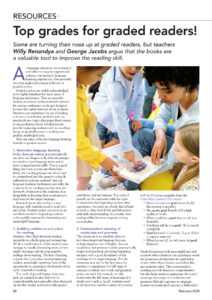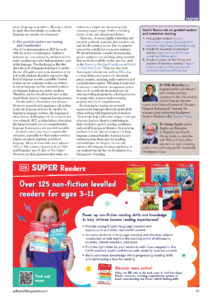Top Grades for Graded Readers
Willy A Renandya, 25 Dec 2023 (EL Gazette – 2024)


Introduction
As language educators, we constantly seek effective ways to support and enhance our students’ language learning experiences. One powerful strategy, widely acknowledged to be highly beneficial for language proficiency development but often neglected, is the graded reader. Graded readers are specially written reading materials tailored for various proficiency levels and designed to meet to varied interests of our students. Students can experience the joy of reading a fiction or non-fiction graded reader of practically any topics that pique their interest (e.g., thrillers, adventures and travels) at any proficiency level (e.g., A1, A2, B1 etc). Graded readers provide beginning students with an excellent bridge to gradually move to reading non-graded, unabridged texts.
In this short article, I explore some of the key language learning benefits of graded readers and encourage ELT educators to incorporate them in their teaching.
1. Immersive language learning
In the classroom setting, teachers typically use short and linguistically difficult passages to introduce new language items (e.g., new words or grammar points) and to teach comprehension skills (e.g., inferencing, summarizing). This is a good thing, but there are two problems here. Firstly, the reading passages are often hard to comprehend and the quantity is hardly sufficient to activate students’ internal language learning mechanism. Secondly, the contents of the reading materials may not always be of interest to the students, thus doing little in boosting their motivation to read more in the target language. Research shows that to learn a new language well, students need to read a lot and often. Graded readers can serve as an excellent means for beginning students to be joyfully immersed in interesting and meaningful language.
2. Building confidence and a love for reading
Students often find classroom reading materials too challenging and uninspiring. While a small minority of the students may manage to handle demanding texts, others might disengage and develop negative feelings about reading. The fear of reading is particularly prevalent among beginning readers, potentially depriving them of the opportunity to experience the benefits of the cycle of growth in reading. The cycle of growth begins when they pick up a graded reader, find it to be comprehensible and enjoyable; they then pick up another reader and read it with greater confidence and enthusiasm. The cycle of growth can be contrasted with the cycle of stagnation that beginning readers often experience: they pick up a book, find it hard to read, so they read slowly and laboriously with little understanding. As a result, their reading ability becomes stagnant or may even decline.
3. Contextualized learning of vocabulary and grammar
The classroom is an excellent place to introduce important language features to beginning learners of English. Indeed, vocabulary and grammar can be systematically taught and practiced, providing beginning students with a good foundation of the workings of the target language. But the classroom may not be the best place for students to experience the full range of contexts in which a new word or grammar point is used. For example, to fully understand the full range of meanings of a simple word such as ‘good’, students need to see how it is used in a variety of contexts. Below are examples of the different nuances of meanings of ‘good’ which I extracted from Cambridge Learners’ Dictionary:
- Have you read any good novels lately? (Interesting, enjoyable)
- She speaks good French. (Of a high quality or level)
- When would be a good time to call you. (Suitable)
- A holiday will do you good. (To be useful or helpful)
- Good heavens! It’s already 11 p.m. (Used to express surprise)
- When he was 20, he left home for good. (Forever)
- etc.
Graded readers provide meaningful and rich contexts where students can experience words and grammatical structures in captivating stories rather than discreet vocabulary lists and grammar rules. This contextualized learning not only improves comprehension but also helps students appreciate the varied meanings and usages of vocabulary and grammar and further strengthen their previously learned language. Multiple exposure to language features in meaningful contexts is believed to propel language acquisition, allowing students them to apply their knowledge to authentic language use outside the classroom.
4. But graded readers are boring and inauthentic!
One of the misconceptions in ELT has to do with the notion of authenticity. Authentic materials are those written by and intended for native speakers of the language. The thinking goes like this: since the goal of language learning is to enable the use of English in authentic situations in the real world, students should be exposed to this kind of language as early as possible. Graded readers are not authentic as they are written in simple (some say unnatural) language and the intended audience are language learners, not native speakers. So these readers should not be used as they would derail students’ language learning process.
On the surface, this makes a lot of sense. However, research and experience tell us that authentic language may not be suitable for beginning language learners; the language is often too challenging and the contents not very relatable. ELT scholars believe that when the input materials are not comprehensible nor relatable, language learning may not proceed smoothly.
Graded readers have faced considerable criticisms, especially for their earlier versions which contained simplistic and bland language. Many of these titles were adapted 19th or 20th century classics such as Pride and Prejudice and A Tale of Two Cities. It is understandable that the older graded readers were often frowned upon by practitioners. Modern graded readers today are written in a simple and interesting style and cover a wider range of titles, from movie tie-ins (e.g., Finding Nemo and the Harry Potter series), non-fictions (The 10 Things to Do and See Series by Andy Boon) and original fictions (e.g., The story of Tracy Beaker by Jacqueline Wilson and Boys Don’t Cry by Marorie Clarke). The last two titles were winners of the 20th Annual Language Learner Literature (LLL) Award organized by the Extensive Reading Foundation.
There are of course highly interesting and readable authentic materials that teachers can and should continue to use. But the majority may not be suitable for our novice students. We should therefore consider incorporating graded readers in our teaching, using materials that are freely available on the Internet (e.g., Extensive Reading Foundation’s collection of free graded readers, British Council Story Zone) or those that require subscription (e.g., https://xreading.com/). The latter is a virtual library with nearly two thousand graded readers that are supported by an easy-to-use learner management system. Xreading can be seamlessly integrated into our existing reading programmes, allowing teachers to assign titles, monitor student reading and check reading progress.
Conclusion
In conclusion, graded readers are powerful resources for language educators, particularly when working with beginning level students. These books help address the unique challenges of novice learners, thereby contributing to their vocabulary growth, reading confidence, and overall language proficiency. As practicing teachers, it is our duty to recognize the huge language learning benefits of graded readers and incorporate them into our teaching methodologies. In doing so, we not only enhance the language learning experience of our students but also lay the foundation for a lifelong love of reading.
Useful Resources on Graded Readers and Extensive Reading
https://erfoundation.org/wordpress/graded-readers/
https://erfoundation.org/wordpress/bibliography/
https://willyrenandya.com/the-primacy-of-extensive-reading-and-listening
Current Practice of Extensive Reading in Asia: Teachers’ Perceptions

